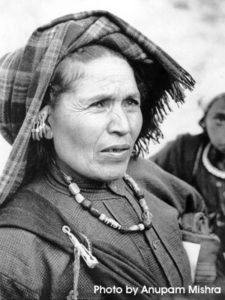
Gaura Devi who led the women in Renni Village
Women prevent the felling of trees
On March 26, 1974, a group of men arrived stealthily in the forest next to Renni Village in the Garhwal District of Himalayas in India. They had been sent by a contractor to begin cutting down 2500 trees in the forest. Anticipating resistance from the villagers, the contractor had ensured that all the men were away on that day.
Word of the arrival of the axe-men spread in the village and the women came out of their houses. About 25 of them, led by Gaura Devi, confronted the contractor’s men. They pleaded with the men not to start the felling operations, but the men responded with threats and abuses. As the confrontation continued, more women joined the protest. Ultimately, the men were forced to leave, since the women did not budge.
Chipko Movement
This small event was a milestone in the Chipko Movement, which became known all over the world as a symbol of people’s action in preventing the destruction of the environment. ‘Chipko’ means ‘to cling’ or ‘to hug hard’. The vision of women hugging the trees and daring the axe-men to cut them before cutting the trees inspired environmentalists the world over.
The contract system allowed rich contractors from the plains to make huge profits from cutting trees on the hills. The Chipko Movement was a response of the hill communities to the unfair and destructive nature of this system. The movement spread rapidly across the Himalayan Region in the seventies.
The Chipko Movement brought unprecedented energy and direction to environmental preservation in India. It was a non-violent and a people’s movement. Further, women took part in it in large numbers. Unfortunately, Chipko lost its steam before its immense potential could be realized. Exaggeration of its strengths, excessive adulation, ego clashes among the key players – all contributed to the sapping of its energy. However, Chipko ensured that the contract system was abolished and the indiscriminate felling of trees stopped.
Other movements
Chipko also inspired other such movements. In September 1983, the villagers of Salkani in the Uttara Kannada district of Karnataka launched a similar movement to save their forests. Men, women, and children of Salkani ‘hugged the trees’ in Kalase forest. It was called ‘Appiko’, which is the term in Kannada language for “hugging”. The Appiko Movement created greater environmental awareness all over southern India.
In 1995, women in the Ryala Region of Tehri Garhwal launched a Chipko-like movement to save giant trees on the hills. The women tied a sacred thread (raksha sutra) around 1000 trees, which had been marked for cutting. Chipko also inspired other movements such as the Narmada Bachao Andolan in Madhya Pradesh and the Chilka Lake Agitation in Orissa.
Afterword: Chipko was a simple and yet powerful idea that caught the imagination of the people. It remains one of the famous environmental movements of the world. We can hope for new Chipkos to arise in the future.

Oh! yes, some of us have grown with these little things being narrated to us time and again. In the past schools in India used to have a class called moral science, and not as a part of the curriculum for writing exams. But it gave the teachers a space to bring about topics like these, so that children are sensitised to issues like the Chipko movement. Sadly, this is missing in many schools as we all in a rat race.